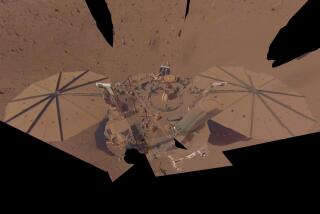Mars may not have the water we thought it did, study shows
When it comes to signs of flowing water on Mars, planetary scientists might be getting left high and dry. New research reveals that mysterious dark streaks long thought to be signs of seasonal water activity might actually just be caused by dry sand.
The findings, described in the journal Nature Geoscience, indicate that the idea that microbial life might exist on the planet today may not hold water.
Scientists believe our rusty, dusty neighbor once had an atmosphere capable of supporting puffy clouds and bodies of liquid water. If this habitat lasted long enough, it could have allowed for microbial life to emerge.
Even though the planet looks dry and desolate today, Mars still has water — except it’s mostly locked up in polar ice caps or frozen beneath the ground. But researchers have increasingly seen hints that water may, rarely and briefly, flow just beneath the Red Planet’s surface, and have wondered whether there could be extreme forms of life surviving there today.
There are gullies on certain Martian slopes that look as though they could have been carved by water. There are also strange dark streaks that grow in warmer seasons and disappear as it cools. Scientists have long thought these are caused by water flowing just under the surface. These streaks are called recurrent slope lineae, or RSL, and they’re found in dark parts of Mars with steep rocky slopes, in the mid-latitudes and near the equator.
But a new paper by an international team of researchers challenges that notion. Colin Dundas of the U.S. Geological Survey in Flagstaff and colleagues used images from the HiRISE camera on NASA’s Mars Reconnaissance Orbiter to create 3-D models of the terrain around 151 of these streaks. They found that no matter how long the streaks were, they seemed to end at around the same angle on these slopes — behavior that’s been seen from sand grains rolling down dunes on Earth, but not from liquid water.
In addition, those slope-side gullies could simply be caused by frozen blocks of carbon dioxide, or dry ice, previous work has shown.
“If both are essentially dry phenomena, this suggests that recent Mars has not had considerable volumes of liquid water, consistent with older models,” the study authors wrote.
What little liquid water remains near the planet’s surface, they added, wouldn’t really be able to sustain life.
“Flowing liquid water in the current Martian climate has always been an extraordinary claim,” the authors wrote. “The observations and interpretations presented here suggest that RSL are no longer extraordinary evidence.”
But there is a bright side, the scientists point out: NASA and other space-exploring outfits don’t have to worry as much about contaminating a new ecosystem with Earth microbes if there’s nothing living there and virtually no water to support invading microscopic Earthlings either.
“Liquid water volumes may be small or zero,” they wrote, “alleviating planetary protection concerns about habitable environments.”
Follow @aminawrite on Twitter for more science news and “like” Los Angeles Times Science & Health on Facebook.
MORE IN SCIENCE
Book the next rocket to New York? What it’ll take to realize Elon Musk’s bizarre travel plan
This new satellite could produce the most accurate weather predictions yet
Satellite on the fritz? Aerospace companies are building a geek squad of space robots







